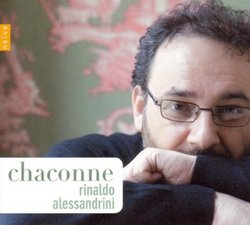| All Artists: Frescobaldi, Couperin, Purcell, Alessandrini Title: Chaconne Members Wishing: 0 Total Copies: 0 Label: Naive Original Release Date: 1/1/2010 Re-Release Date: 7/27/2010 Genre: Classical Style: Number of Discs: 1 SwapaCD Credits: 1 UPC: 709861304684 |
Search - Frescobaldi, Couperin, Purcell :: Chaconne
 | Frescobaldi, Couperin, Purcell Chaconne Genre: Classical
|
Larger Image |
CD Details |
CD ReviewsThoroughly Delightful J Scott Morrison | Middlebury VT, USA | 08/11/2010 (5 out of 5 stars) "The notion of issuing a CD in which all the works presented are chaconnes (or passacaglias) on the face of it seems like a brilliant idea. But, in fact, during the baroque era the chaconne (or passacaglia) was darn near ubiquitous. Composers of that era loved building sets of variations based on a ground bass. Rinaldo Alessandrini, one of the leading lights in today's baroque music world, is an extremely skilled conductor and, it goes without saying, a terrific harpsichordist. He has put together a collection of chaconnes/passacaglias encompassing the works by eleven baroque composers and two composers from the present day.
Technically the chaconne and the passacaglia are two dances of the baroque era that differ in significant ways. The passacaglia is a set of variations built upon a bass that is a descending tetrachord, the chaconne built on a bass that touches upon the principal degrees of the work's key. In practice, however, this distinction quickly became blurred and indeed today the two are considered by composers and listeners alike to be virtually synonymous. Alessandrini, in his booklet notes, comments that composers subsequent to the Baroque era have been drawn to the form as well -- indeed he plays one each by György Ligeti and by himself -- and he mentions several prominent post-baroque practitioners. It struck me that he didn't mention one of the greatest of modern-day passacaglia writers, Dmitri Shostakovich, but no matter. He does mention Webern, Berg, and Schoenberg and also refers to the monumental finale of Brahms's Fourth Symphony. As of the date of this review, Amazon provides clips from each of Alessandrini's selections, but doesn't name their composers. They are, in order: Girolamo Frescobaldi, Juan Batista José Cabanilles, Bernardo Storace, Louis Couperin, Johann Kaspar Kerll, Henry Purcell, Ligeti, Couperin again, Georg Muffat, François Dagincour, Johann Kaspar Ferdinand Fischer (two pieces), George Frideric Handel, Antoine Forqueray, and Alessandrini himself. The pieces are enough different from each other to avoid boring repetition and Alessandrini's playing is superb. He is playing a beautiful instrument whose provenance, strangely, is not given. Recommended. Scott Morrison" |

 Track Listings (16) - Disc #1
Track Listings (16) - Disc #1